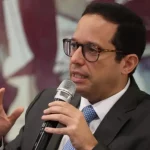The most recent survey conducted by the National Consulting Center for the weekly magazineshows how the photo was in the voting intention of Colombians, after the inter-party consultations.
(The pillar regime proposed by Petro for the pension system).
Gustavo Petrowith 32% and Federico Gutiérrez, with 23%, lead the intention to vote for the presidential elections in May this year.
For their part, in third place, in a technical tie, appear the candidates Rodolfo Hernandez and Sergio Fajardoboth with 10% intention to vote, according to this study, which has a margin of error of 2.1% and a confidence level of 95%.
At the same time, Ingrid Betancourt registers an intention of 3% and Enrique Gómez, of the National Salvation Movement, reaches 1%.
(The effect of elections on markets).
The study highlights that there are 13% of undecided people (does not know/does not answer) and 5% who stated that their vote will be blank.
The survey represents an increase of five percentage points for Petro with respect to the previous study of voting intention of the CNC, carried out in February this year before the internal consultations.
Gutiérrez, for his part, has a jump of 19 points compared to the 4% registered in February. Hernández, in turn, dropped 4 points, while Fajardo increased the same amount.
This is the technical sheet of the survey
NATURAL OR LEGAL PERSON WHO
DONE: National Consulting Center SA
NATURAL OR LEGAL PERSON WHO
COMMITTED: Weekly magazine
FUNDING SOURCE: Weekly magazine
UNIVERSE UNDER STUDY: Women and men over 18 years of age, residents in the municipalities of Colombia and intending to vote in the next presidential elections. As a statistical stratification mechanism, 6 geographic regions were established as follows: (1) ANTIOQUIA + COFFEE GROWTH: Antioquia, Caldas, Quindío and Risaralda; (2) BOGOTA: Bogota DC; (3) CARIBBEAN: Atlántico, Bolívar, Cesar, Córdoba, La Guajira, Magdalena, Sucre, San Andrés and Providencia; (4) CENTER: Boyacá, Cundinamarca, Huila and Tolima; (5) PACIFIC: Cauca, Chocó, Nariño and Valle del Cauca and (6) SOUTHEAST: Arauca, Caquetá, Casanare, Meta, Norte de Santander, Putumayo and Santander
SAMPLING DESIGN:
The sampling design is probabilistic, in four stages and stratified with the selection of simple random samples of statistical units in each stage.
In the first sampling stage, a selection of municipalities was made within each geographical region (statistical stratum), considering Bogotá, Medellín, Cali, Barranquilla, Bucaramanga, Ibagué, Villavicencio and Cúcuta as municipalities of forced inclusion in the sample; From the rest of the municipalities in the universe under study, the random selection of some of them was carried out; in total 43 municipalities. In the second stage, a random selection of cartographic blocks was carried out within the selected municipalities, based on the sampling frame. In the third stage, households were selected within the selected cartographic blocks (in each block 4 households were selected) and in the final stage, an adult within the household. The selection of statistical units was operationalized through the algorithm called “negative coordinate”. The sampling frame used is the National Geostatistical Framework provided by DANE. The sampling frame is the device that allows ordering the field operation and offering a guarantee that the implementation of said operation corresponds to the methodological guidelines established for the investigation. The minimum geographical unit that contains said framework is the cartographic block in the capitals of the municipalities of Colombia.
SAMPLE SIZE: 2,143 cases (1,111 by telephone and 1,032 in person) in 45 municipalities in all regions of Colombia
MARGIN OF ERROR AND LEVEL OF CONFIDENCE: Sampling error margin of 2.1% and 95% confidence
TOPICS REFERRED TO: Citizen perceptions and expectations about the Colombian social and political reality and about the pre-electoral environment
QUESTIONS ASKED: 2 questions. For more details please consult the questionnaire
FIELD WORK PERIOD: March 18 and 19, 2022
COLLECTION TECHNIQUE: Mixed survey (half telephone and half face-to-face) in households.
For more information, see the following link.
With information from ELTIEMPO.COM
















